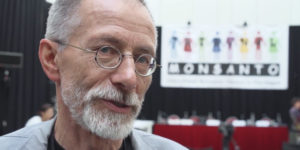EFSA fails to provide evidence to support its decision to dismiss a key study showing glyphosate is carcinogenic.
 The European Food Safety Authority (EFSA) has been accused of excluding from its glyphosate assessment a key study only because of a negative comment by a former US Environment Protection Agency (EPA) official.
The European Food Safety Authority (EFSA) has been accused of excluding from its glyphosate assessment a key study only because of a negative comment by a former US Environment Protection Agency (EPA) official.
The former US EPA official, Jess Rowland, is under investigation in a US court case brought by cancer sufferers, who believe that exposure to Roundup triggered their disease. Based on internal Monsanto documents disclosed in the lawsuit, Rowland is accused of colluding with Monsanto to defend glyphosate’s health record.
The accusation against EFSA was made by the toxicologist Dr Peter Clausing, representing Pesticide Action Network (PAN) Germany, at a scientific conference on glyphosate’s health risks, held in the EU Parliament on 10 May. The conference was hosted by the Czech Socialist MEP Pavel Poc.
Dr Clausing said that he had met the head of EFSA’s pesticides unit, Jose Tarazona, the previous week. They had discussed a key study (Kumar 2001) showing that glyphosate caused malignant lymphoma in mice. Dr Clausing said that Dr Tarazona was not able able to give any concrete reasons why the study was excluded from EFSA’s assessment, other than that a US EPA observer had said the US EPA had not accepted it due to viral infections in the animals.
According to a report in EU Food Policy,[1] EFSA and PAN agree that the US EPA observer was Jess Rowland, who made the remark about infections during a teleconference about glyphosate organised by EFSA in 2015.
However, EFSA told EU Food Policy that
“it and member states had already picked up on weaknesses with the study and that the majority of member states had agreed there was a high background of malignant lymphomas in the mice used for the study.”
The EU Food Policy article goes on to quote Dr Tarazona as saying that Rowland informed EFSA “about potential flaws in the Kumar study (2001) related to viral infections that could influence survival as well as tumour incidence”.
Dr Tarazona told EU Food Policy that EFSA didn’t just take Rowland’s word for it:
“After the teleconference, EFSA experts checked the Kumar (2001) study themselves and found additional indications that confirmed deficiencies in the health status of animals, which supported the plausibility of a viral infection.”

Dr Tarazona told EU Food Policy that Dr Clausing’s remarks “give rise to concerns about the integrity of EFSA’s glyphosate assessment”, but that this is “not borne out by the facts”.
No evidence for alleged “viral infections”
So what were these “additional indications that confirmed deficiencies in the health status of animals, which supported the plausibility of a viral infection”?
EFSA has had plenty of chances to describe them.
First, in its “Conclusion on the peer review of the pesticide risk assessment of the active substance glyphosate”, published in 2015, EFSA declared the Kumar study as
“not acceptable due to viral infections that could influence survival as well as tumour incidence – especially lymphomas”.
And second, in a peer-reviewed paper of the same year explaining why EFSA had come to a different conclusion on glyphosate’s carcinogenicity from the World Health Organisation’s cancer agency IARC (which classed it as a probable carcinogen), Dr Tarazona and his co-authors from EFSA and Germany’s Federal Institute for Risk Assessment (BfR) say that the Kumar study “was excluded due to a likely viral infection in the experimental population”.
But in neither document does EFSA give any supporting evidence for viral infections.
 And in neither document does EFSA describe any “additional indications that confirmed deficiencies in the health status of animals, which supported the plausibility of a viral infection”, such as Tarazona claimed were present in the Kumar study.
And in neither document does EFSA describe any “additional indications that confirmed deficiencies in the health status of animals, which supported the plausibility of a viral infection”, such as Tarazona claimed were present in the Kumar study.
In fact there is an irrefutable (by the EU authorities, at least) source that states that there is no evidence whatsoever that the animals in this experiment suffered from a viral infection or that their health was deficient as a result of such an infection. That source is none other than the CLH (harmonised classification and labelling) report on glyphosate, based on industry data and submitted by the German Federal Institute for Occupational Safety and Health (BAuA) to the European Chemicals Agency (ECHA).
The CLH report states:
“During a teleconference (TC 117) on carcinogenicity of glyphosate hold [sic.] by EFSA… it was mentioned by an US EPA observer that the Kumar (2001, ASB2012-11491) study had been excluded from US EPA evaluation due to the occurrence of viral infection that could influence survival as well as tumour incidences, especially those of lymphomas. However, in the study report itself, there was no evidence of health deterioration due to suspected viral infection and, thus, the actual basis of EPA’s decision is not known” (p. 72).
Nevertheless, ECHA continued to use the narrative of a virus infection in spite of its admission that there was no evidence for such an infection. In its Opinion, ECHA cautions against “a possible role of oncogenic viruses” – which it apparently deemed as sufficient reason to exclude this important study from the overall assessment.
Unsurprisingly, having disposed of Kumar using an apparently evidence-free argument, ECHA followed EFSA in concluding that glyphosate is not carcinogenic.
Dr Tarazona’s identification of the “US EPA observer” as Jess Rowland raises questions about the influence on the EFSA glyphosate assessment exercised by this man – who allegedly boasted to a Monsanto executive that he deserved a medal if he could kill another agency’s investigation into the chemical’s health risks.
“Viral infection” claim first shows up in Monsanto-supported paper
It seems that Rowland himself did not come up with the narrative of the “viral infection”. It first appeared in a Monsanto- and Glyphosate Task Force-supported review, which concluded that glyphosate was non-carcinogenic. The review was co-authored by Monsanto employee David Saltmiras and published in the journal Critical Reviews in Toxicology, which has industry ties. However, even this review introduces the idea of a viral infection in tentative language, referring to a “possible viral infection” that “may have confounded interpretation of results”.
EFSA goes much further than this Monsanto-linked paper in its unqualified claim that the Kumar study was “not acceptable due to viral infections”.
Malignant lymphoma-prone mice?
But what about the other supposed weakness in the Kumar study, the “high background of malignant lymphomas in the mice used for the study” that EFSA mentioned to EU Food Policy?
That argument doesn’t stand up either, according to Dr Clausing. He told GMWatch that while a good number of control mice did get malignant lymphomas, the glyphosate-treated mice had a statistically significant increase in malignant lymphomas, in a clearly dose-dependent fashion. Moreover, this statistically significant increase in malignant lymphoma was well above the range of historical control data (the “background” incidence referred to by EFSA) – supporting the observation of a glyphosate-induced carcinogenicity.
Dr Clausing said that these were valid historical control data as measured by OECD standards. This was important because there are a number of examples where EFSA used invalid historical control data to dismiss significant findings of carcinogenicity.
GMWatch believes that for EFSA to claim that these increases were due to chance and not to glyphosate is to turn its back on the scientific method.
The study that had to be killed
Dr Clausing believes that the Kumar study, together with two other studies showing the same effect, presents difficult-to-refute evidence of glyphosate’s carcinogenicity. Its particular significance within EFSA’s assessment is that the reasons used by EFSA to dismiss other studies showing glyphosate is carcinogenic do not apply to the Kumar study and a second study by Wood et al. (2009). In both studies the increase in malignant lymphoma in glyphosate-treated animals was both dose-dependent and significant, at doses that could not be dismissed as only a “high-dose phenomenon”.
In reality the Kumar study is far from being an outlier. Before EFSA produced its assessment, the German authority BfR, under pressure from the IARC verdict, had demonstrated statistically significant increases in cancer in seven rodent carcinogenicity studies with glyphosate. But EFSA denied these results, using what Dr Clausing considers spurious arguments, and insisted that there was only one mouse study – Kumar – with statistical significance.
According to the European legislation, evidence for carcinogenicity in at least two separate studies is “sufficient evidence” to label a compound as carcinogenic (category 1B). That would mean an automatic ban. Thus in Dr Clausing’s view, the Kumar study “presented an obstacle” to EFSA’s apparent intention to declare glyphosate as non-carcinogenic: “That’s why the exclusion of this particular study from further consideration was so important.”
Dr Clausing is not the only authority to believe that the Kumar study was particularly problematic for those who wish to argue that glyphosate is non-carcinogenic. The BfR remarked in its assessment of glyphosate that this unpublished industry study “was apparently not available to IARC” – “otherwise, it would have been certainly used as the first place argument for carcinogenicity of glyphosate” (p. 9).
Flawed study included by EFSA
Dr Clausing argued in his presentation to the EU Parliament that the Kumar 2001 study should have been included by EFSA in its assessment and that a study by Atkinson (1993), which found no carcinogenic effect of glyphosate, should have been excluded. The latter study was invalid, he explained, because only animals with signs of malignant lymphoma that were visible to the naked eye were examined more closely – a recipe for missing numerous cases. This flawed study was used as additional “proof” that glyphosate did not cause malignant lymphoma.
If EFSA had included Kumar and excluded Atkinson, it would not have concluded that glyphosate was not carcinogenic, Dr Clausing told the meeting.
Did Rowlands mislead EFSA on glyphosate?

Court documents released on March 13th show that Monsanto colluded with the EPA to bury scientific evidence linking its glyphosate product (RoundUp) to cancer in humans (specifically, Non-Hodgkin’s Lymphoma). (Source: Natural News)
In light of Jess Rowland’s role in the assessment of carcinogenicity of glyphosate in the US as reflected by the internal Monsanto documents, there are serious concerns that he might have influenced the decision by providing wrong information. Yet EFSA is not an innocent victim in this case. It apparently failed to properly scrutinize Rowland’s claim.
To summarize, the only publicly available explanation for EFSA’s dismissal of the Kumar study due to a viral infection is Rowland’s claim – yet there is no factual evidence whatsoever to back up the claim. Dr Clausing said he has examined the publicly available documents as well as the raw data of the Kumar study, which was made available to him by EFSA. He said,
“Scrutinizing all these documents did not provide any other evidence than the Rowland intervention. As a result, I have doubts about the integrity of EFSA’s assessment of glyphosate. Those doubts have been sown by EFSA itself.”
Note
1. EU Food Policy. EFSA refutes claims it was improperly influenced on glyphosate. 15 May 2017. Subscription only (eufoodpolicy.com); no direct link.
Featured image: GMWatch
